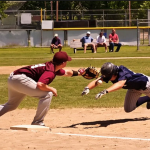CCA Podcast 088: Handling Slumps
Podcast: Play in new window | Download | Embed
Subscribe: RSS
Quick quiz…
a.) Who went 0-20 in 1960?
b.) Who went 0-24 in 1965?
c.) Who began the 1955 season 0-24?
d.) Who went 1-23 in 1978?
e.) Who went 0-32 in 2004?
f.) Who went 5-25 in the 1945 World Series?
g.) What do they all have in common?
Answers…
a.) Mickey Mantle
b.) Willie Mays
c.) Roy Campanella
d.) Mike Schmidt
e.) Derek Jeter
f.) Ted Williams
g.) They either are, or will be Hall of Famers.
How did some of the greatest players to ever set foot on the planet end up in such incredible funks? The real answer is probably not mechanical (although that is the first place most of us look). The real answer probably has two components 1.) small sample size and 2.) mental.
Small Sample Size
Batting Average is an antiquated statistic and doesn’t tell the whole story, but I will use it here because of its simplicity.
After roughly 20 plate appearances in 2016 here are the current MLB leaders in batting average:
| Dexter Fowler, CHC | .526 |
| DJ LeMahieu, COL | .526 |
| Yasiel Puig, LAD | .455 |
| Matt Kemp, SD | .429 |
| Jean Segura, ARI | .423 |
Nobody in their right minds believes that any of these players will maintain this level of success throughout the year. Not a single one of those players has a career average within .250 points of their current average, and not a single one of them will maintain their average for more than a few more games. At the end of the season, the familiar names will replace many these players at the top of the list. But when a player is struggling through an 0-20, people question their ability and assume they must not be a very good hitter.
Why? Because almost anything can happen in small sample sizes. To hit .600 over a few games, you need good breaks. Every ground ball you hit must have eyes, every bloop you hit has to fall, and every ball you hit hard has to find an opening.
Likewise, over a small sample, to go 0-20, every ground ball has to be gobbled up, every bloop gets caught, and every ball you hit hard goes right to someone.
Many players do not understand the concept of small sample sizes, and it causes them to press and become frustrated when an 0-10 pops up during their season. In reality, it’s probably just a random series of events that they will overcome as they get more at bats.
Coaches can contribute to this problem greatly, by having knee jerk reactions to this player who goes 0-10. Dropping them in the line-up, or pulling them all together when your eyes tell you they are clearly better than the current results they are having, will compound this problem.
Trust what you see, not always what the numbers tell you over a small sample (especially batting average!), and give players a chance to get more at bats before making decisions based on randomness.
How coaches and players can attack slumps through the mental game
1.) Acknowledge the slump, but don’t be consumed by it:
When a player is 0-15, it is the 2000 pound elephant in the room. Everyone knows they aren’t getting results, and they should acknowledge they are going through a rough patch. Then all talk of batting average stops there. If the slump continues, there should be no focus on the batting average of the player.
2.) Focus on the process, not the results:
If the focus is on the 0-15, it will consume the player, and it will be more difficult for them to come out of their slump. Encourage them to focus on every single pitch, not what has happened in the past. That 0-15 has already happened and cannot change. The player has no control over the next 15 at bats, all they can control is the current pitch.
Their focus should be solely on winning every single pitch, getting a good pitch to hit, and hitting it hard. If they are able to do that, they are more likely get out of the slump quickly. If they aren’t, the slump will consume them, and they will be stuck in it longer.
3.) Measure the correct statistics:
Let’s look at two case studies to illustrate how bad and meaningless of a statistic batting average can be…
Case Study #1 - Single Game
Player 1 - Gets an infield single, a bloop hit over the shortstop’s head, and strikes out twice.
Player 2 - Walks, hits a hard line drive right at the centerfielder, hits a hard ground ball that scores a runner from third, and lines out to the first baseman.
Batting average says Player 1 is hitting .500, and Player 2 is hitting .000.
Looking at Quality at Bat %, Player 1 has 50% quality at bats (mostly by luck) and Player 2 has 100% quality at bats. In fact, Player 2 has a batting average of .000 only by bad luck, but every single one of their at bats has been quality.
Case Study #2 - A Slump?
Four games into a season, a player is 1-10 with 6 walks and 2 hard hit balls. This player believes they are in a slump because they are hitting .100. However a deeper look at the statistics show that they have actually reached base 43.75% of the time (PRETTY GOOD!), and their QAB % is 56.25% (again… pretty darn good!).
Is this player, who is hitting .100 in a slump? Not at all! They have actually been pretty productive, even though most players, coaches, and fans would look at their .100 batting average and think they are either in a slump or not very good.
At this point, the player has two decisions, they can become consumed by the slump (which really doesn’t exist), or they can play the game one pitch at a time, recognizing they HAVE been productive.
This same player wouldn’t feel they were in a slump if those two hard hit balls fell in and they got a bloop single or infield hit somewhere in there. With those same at bats and just a little more good luck, they would be hitting .400 with a .563 OBP, and the word slump would never even creep into their head.
Conclusion: Batting Average is horribly misleading!
4.) Do not let the slump (if it exists at all) get in the way of the rest of their game.
The absolute WORST thing a player in a slump can do is to sulk, feel sorry for themselves, and let what is happening at the plate affect the rest of their game. This is horribly selfish, self-centered, and shows immaturity.
The only focus of truly quality players is helping the team in any way possible on every single pitch. If they have 4 bad at bats that day, they can still play quality defense and help the team win. If a player is scuffling at the plate, the coach may ask them to bunt to help the team win, or to contribute in some other way. This should be looked at as a positive opportunity to help the team.
Remember, it isn’t about them and their batting average, it is about helping the team win on every pitch. There are many, many more ways to do that besides hitting.
5.) Don’t start changing things!
If the player has had success in the past, and is mired in an 0-15 slump, the first question they will ask is “what am I doing wrong?” Many players don’t like my answer. Most of the time it’s “nothing.”
Hitting a baseball is an incredibly difficult thing to do. You can get a good pitch to hit, put a good swing on it, miss by 1/4 of an inch, and it’s a pop-up. Do that a few more times, hit a few balls hard right at someone, take a few bad at bats, and the first thing many people want to do is start changing mechanics.
Don’t get me wrong, I’m all about making improvements or correcting mechanics if they have changed for the worse. But, if you take that 0-15 player and start changing mechanics, now we have a player in a slump who is trying something new. That is a recipe for disaster.
So when the slumping player looks for answers, start with their mental approach, pitch selection, and have them focus on one pitch at a time. Only correct mechanics if they have gotten away from something they were doing previously when they were having success.
Conclusion
Slumps are very frustrating for players, and coaches alike, but they happen to every skill of player at every level of the game. Nobody is immune from them, and nobody can control when they happen. The only control coaches and players have is their reaction to them. React appropriately and the slump will be a thing of the past faster than they got into it. React poorly, and it will consume every aspect of their game, negatively affect the team, and require that the player (who may be one of the best 9) be removed from the line up.
If you or one of your players is going through a tough time, just remember, Mantle, Mays, Campanella, Schmidt, Jeter, and Williams...
If you enjoyed this article and are interested in learning more about hitting and staying out of those slumps, get our "Top 5 Hitting Drills That Translate Practice Skill to Game Performance:
 Posted by Kyle Nelson
Posted by Kyle Nelson- Posted in Hitting
 Mar, 27, 2017
Mar, 27, 2017 2 Comments.
2 Comments.
Elite members login here
Check out what’s New/Hot!
Recognizing, Diagnosing, and Fixing Common Hitting Flaws eCourse The 3 metrics we tested on Blast motion sensors this year Sneak Peek Inside an Elite Q and A The batting practice continuum Elite Member’s area table of contents 50+ “Chaos” hitting drills
5 sample Chaos hitting drills FREE
Mental Skills and Culture Building The hitting pyramid Welcome Elite Member, Trey! Ideas for a pitcher first practice 12 week bat speed improvement plan Make plans this offseason to have your team playing their best baseball at the end of the year” Top 5 hitting drills to translate practice skill to game performanceHow we used Blast Motion sensors with a team in 2019
What to do if your hitters are overmatched Welcome Elite Member, Tommy! Setting your baserunners up for success Welcome Elite Member, Mike! A consulting call with Elite Member Matt FREE Web Clinic: Developing Athletic, Consistent, Extraordinary Infielders
 Coach Kyle Nelson
Coach Kyle Nelson






Well done Coach Nelson! Couldn’t agree more.
In the words of Steve Springer, “The batting average is evil.” It is really misleading especially if you are a HS player that may only get 60-80 ABs in a season. It’s a lot easier to stay positive if you concentrate on hitting the ball hard and doing the small things to help your team win…like moving the runner over, having an 8 pitch AB, etc.
Coach Kuebler
http://www.colonialbaseballinstruction.com
[…] Handling Slumps – blog post adds to the topic of this podcast by identifying the "causes" of slumps, and helping players get out of them. […]